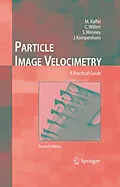This practical guide intends to provide comprehensive information on the PIV technique that in the past decade has gained significant popularity throughout engineering and scientific fields involving fluid mechanics. Relevant theoretical background information directly support the practical aspects associated with the planning, performance and understanding of experiments employing the PIV technique.
The second edition includes extensive revisions taking into account significant progress on the technique as well as the continuously broadening range of possible applications which are illustrated by a multitude of examples. Among the new topics covered are high-speed imaging, three-component methods, advanced evaluation and post-processing techniques as well as microscopic PIV, the latter made possible by extending the group of authors by an internationally recognized expert.
This book is primarily intended for engineers, scientists and students, who already have some basic knowledge of fluid mechanics and non-intrusive optical measurement techniques. It shall guide researchers and engineers to design and perform their experiment successfully without requiring them to first become specialists in the field. Nonetheless many of the basic properties of PIV are provided as they must be well understood before a correct interpretation of the results is possible.
Zusammenfassung
The development of Particle Image Velocimetry (PIV), a measurement technique, which allows for capturing velocity information of whole ?ow ?elds in fractions of a second, has begun in the eighties of the last century. In 1998, when this book has been published ?rstly, the PIV technique emerged from laboratories to applications in fundamental and industrial research, in par- lel to the transition from photo-graphicalto video recording techniques. Thus this book, whose objective was and is to serve as a practical guide to the PIV technique, found strong interest within the increasing group of users. The early progress made with the PIV technique might best be char- terized by the experience gained during our aerodynamic research at DLR (Deutsches Zentrum fur ¨ Luft- und Raumfahrt) at that time. The ?rst app- cations of PIV outside the laboratory, in wind tunnels, as performed in the mid-eighties were characterized by the following time scales: time required to set up the system and to obtain well focused photo-graphical PIV recordings was 2 to 3 days, time required to process the ?lm was 0. 5 to 1 day, time - quired to evaluate a single photo-graphicalPIV recording by means of optical evaluation methods was 24 to 48 hours. When the ?rst edition of this book was published in 1998, with electronic cameras and computers, it was pos- ble to focus on-line, to capture several recordings per second, and to evaluate a digital recording within seconds.
Inhalt
Physical and Technical Background.- Mathematical Background of Statistical PIV Evaluation.- PIV Recording Techniques.- Image Evaluation Methods for PIV.- Post-Processing of PIV Data.- Three-Component PIV Measurements.- Micro-PIV.- Examples of Application.- Related Techniques.
